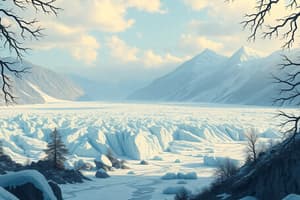Podcast
Questions and Answers
Jakie zjawisko odpowiada za formowanie lodowców?
Jakie zjawisko odpowiada za formowanie lodowców?
- Opady deszczu
- Topnienie lodowców
- Promieniowanie słoneczne
- Kompresja śniegu (correct)
Który rodzaj lodowców jest znany jako dolinowy i znajduje się w dolinach górskich?
Który rodzaj lodowców jest znany jako dolinowy i znajduje się w dolinach górskich?
- Polytermalny
- Paleoglacjalny
- Alpejski (correct)
- Eksopolarny
Co to jest 'rekryształtizacja' w kontekście formowania się lodowców?
Co to jest 'rekryształtizacja' w kontekście formowania się lodowców?
- Opady deszczu na obszarze lodowca
- Topnienie lodu na powierzchni lodowca
- Powstawanie szczelin w lodowcu
- Proces zamieniania się śniegu w lód (correct)
Które zjawisko nie jest przyczyną ruchu lodowców?
Które zjawisko nie jest przyczyną ruchu lodowców?
Jak nazywane są duże, długotrwałe lodowce, które często pokrywają ponad milion kilometrów kwadratowych?
Jak nazywane są duże, długotrwałe lodowce, które często pokrywają ponad milion kilometrów kwadratowych?
Co dzieje się z nowo napadającym śniegiem na lodowiec?
Co dzieje się z nowo napadającym śniegiem na lodowiec?
Co przyspiesza ruch lodowca latem?
Co przyspiesza ruch lodowca latem?
Jaki wpływ na poziom mórz ma topnienie lodowców?
Jaki wpływ na poziom mórz ma topnienie lodowców?
Jakie zagrożenia stoją przed lodowcami w związku ze zmianami klimatu?
Jakie zagrożenia stoją przed lodowcami w związku ze zmianami klimatu?
Jaka działalność przemysłowa może przyczyniać się do zmniejszania lodowców?
Jaka działalność przemysłowa może przyczyniać się do zmniejszania lodowców?
Co to jest erozja glacjalna?
Co to jest erozja glacjalna?
Jakie działania mogą pomóc w dalszym istnieniu lodowców?
Jakie działania mogą pomóc w dalszym istnieniu lodowców?
Flashcards are hidden until you start studying
Study Notes
Glaciers: Ice Giant's of Earth
Glaciers are massive accumulations of ice that form when snowfall exceeds the amount of meltwater during warmer months over many years. These magnificent natural structures can grow to immense sizes, covering vast areas and shaping the landscape around them. Whether they sit quietly on mountaintops or flow like rivers down through valleys, glaciers play a significant role in our planet's ecosystem and climate.
Formation of Glaciers
Glaciers form when snow accumulates over several years and transforms into ice due to compression from the weight of new snowfall. This process is called 'recrystallization.' The snow becomes denser as it is compacted and transforms into glacial ice. As more snow falls on top, the glacier grows in size.
Types of Glaciers
There are three main types of glaciers: Alpine, Polythermal, and Paleoglacial. Alpine glaciers, also known as valley glaciers, are found in mountain valleys and are fed by snow accumulation and ice melt in the same location. Polythermal glaciers are found at lower latitudes and have ice that is both cold and warm. Paleoglacial glaciers, also known as ice caps or ice sheets, are large, long-lasting, and often cover more than one million square kilometers.
Glacier Movement and Flow
Glaciers move due to gravity and are not static objects. They flow slowly from the highest point to the lowest point on their surface, carrying rocks and debris along the way. The speed of glacial movement varies greatly and depends on factors such as temperature, slope, and amount of water present. For instance, during summer, when temperatures rise, glaciers melt and therefore flow faster. During winter, when snowfall increases, they slow down.
Importance of Glaciers
Glaciers play a crucial role in Earth's climate regulation system. As they store large amounts of freshwater, melting glaciers release this water into lakes and rivers, which helps regulate global sea levels. Additionally, some glaciers act as natural reservoirs for drinking water, providing essential resources for millions of people living near them.
Beyond their role in hydrology, glaciers also contribute to shaping the landscape. Their slow but constant movement erodes rock and soil, creating valleys, canyons, and other unique geographical features. This process is called glacial erosion and has played a significant part in shaping many parts of our planet.
Threats to Glaciers
However, glaciers are not invincible. They face several threats, such as climate change, which causes them to melt faster than they form due to rising temperatures. As glaciers recede, this leads to changes in water availability, coastal flooding, and impacts on ecosystems, agriculture, and human settlements. Another threat comes from pollution caused by industrial activities like mining, oil drilling, and deforestation, all of which contribute to global warming and glacier retreat.
In conclusion, glaciers are fascinating natural phenomena that shape our environment and influence Earth's climate. Understanding how these ice giants work will help us better comprehend our planet and the impact we have on it. By taking actions to reduce greenhouse gas emissions and protect fragile environments, we can ensure the continued existence of these wonders for generations to come.
Studying That Suits You
Use AI to generate personalized quizzes and flashcards to suit your learning preferences.




